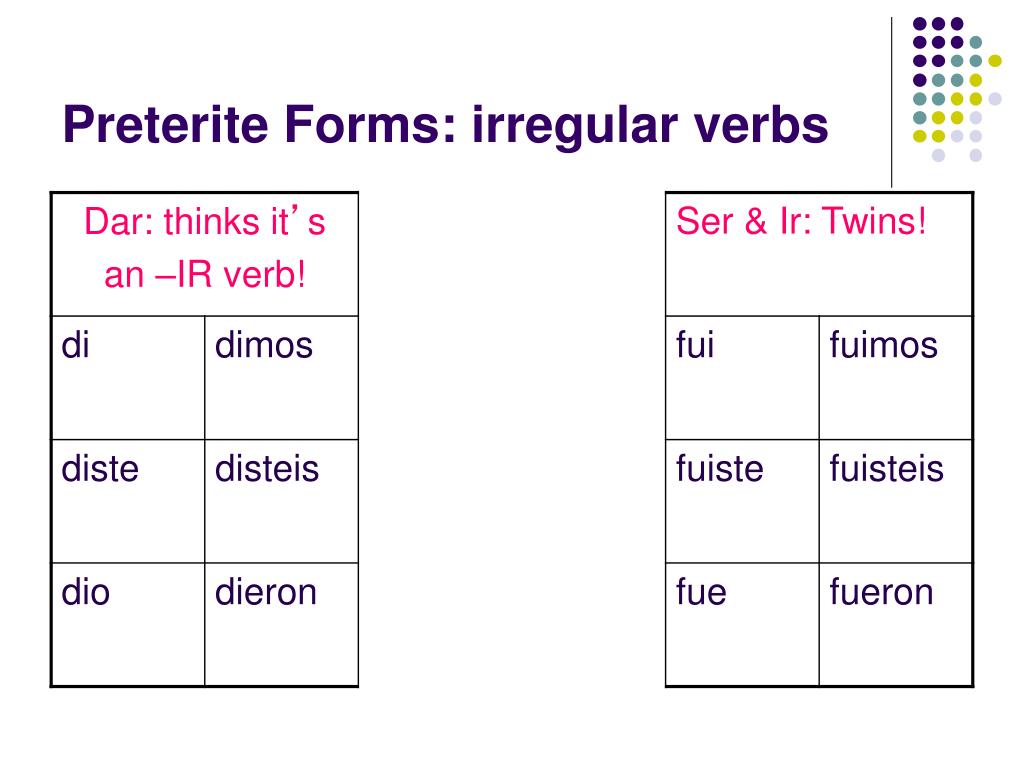

- #Bubble trouble irregular verbs preterite tense answer how to
- #Bubble trouble irregular verbs preterite tense answer movie
- #Bubble trouble irregular verbs preterite tense answer series
Next, whenever you want to list a series of completed events, you would use the preterite tense. – We walked for two hours.Īgain, even though we’re listing a period of time – it still has a defined beginning and end. So we can also talk about actions in the past like this: What’s important is that we are being concrete and specific about our timeframe. The preterite can also refer to a longer point in the past, such as periods of time. The preterite is already referring to a point in the past, but we’re just being more specific here. In both of these examples, we’re specifically using words that express time ( ayer, a las cinco ), but they aren’t necessary.
#Bubble trouble irregular verbs preterite tense answer movie
– Yesterday afternoon I went to the movie theater. In other words – there’s no ambiguity being expressed because we’re talking about a specific point in time. The first use of the preterite is with actions that have a defined ending and beginning. Since the preterite tells us that something only happened once or that an action had a definite end, you might start to see some patterns forming. Now let’s move away from boring charts and on to the fun stuff! There are four main times when you can use the preterite to describe past actions. It’s easy to get overwhelmed learning them all at once, so practice makes perfect! The best thing you can do for the Spanish preterite is to start to look out for some patterns and slowly memorize them one at a time. The good news is – the preterite is the most irregular verb tense out there, so once you can conquer it, the rest of the Spanish language is yours for the taking. Here are just a few of them: Subject PronounĪs you can see here, the irregular verbs will change both in the stem and in the endings. Not only is the regular conjugation for this verb tense a bit complicated, but there are also a ton of irregular verbs.Īnd there’s no better way to learn than by practicing, so here are the regular conjugations: Subject PronounĪs you can see, the ER and IR verbs are exactly the same when it comes to conjugation, so that does make life a bit easier! However, the Spanish language has a ton of irregular verbs for the preterite tense. We’re starting with the preterite tense first because it’s the more difficult of the two.
#Bubble trouble irregular verbs preterite tense answer how to
Sounds pretty easy, right? So let’s move on to learning how to form the preterite. Here you are giving an exact time in the past and the test probably had an established beginning and end. Most of the time, we talk about the pretérito perfecto simple to describe completed actions that have a definite beginning and end. It’s similar to the simple past in English (words that end in -ed), but not exactly the same. The preterite tense is used to explain past events that took place once. Let’s start off strong today and work on the more difficult of the two first. So today let’s go over each of them individually, then talk about some of their major differences at the end. And even though Spanish has around 7 different ways to express the past, these two still remain as troublemakers. These two past tenses tend to lead to a lot of difficulty for English speakers, but today we’re going to take them one step at a time and learn how to master them.įrom learning to tell a story to simply talking about something in your past, it’s crucial to be able to use the past tenses correctly.

Today we are tackling the dreaded preterite vs imperfect.


 0 kommentar(er)
0 kommentar(er)
